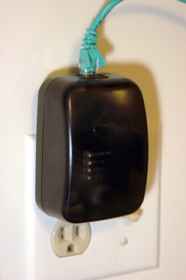I remember my college days when my buddies and I had a tough time getting a dial up Internet connection in our home town. The common excuse we used to get at the phone company was the need for infrasturcture upgrade (laying of new phone lines, etc) or non-allocation of quota to our district. This used to get us all pumped up and we used to have discussions on the possibility of using existing power lines to transfer data signals instead of laying separate phone lines. The idea was scoffed at by several mates who felt that the magnetic fields caused by the leectricity transmission would offer an impedance great enough for the whole idea to never really take wings.
These days, I hear the same complaint from Internet savvy people who are not able to procure broadband signals in their neighbourhood because of lack of last mile connectivity. I use a WLL (Wireless Local Loop) based Internet broadband connection that is anything but fast. The service at times is so poor that I switch back temporarily to my good old dial up connection. With conditions like these, I sometimes wonder what technology would provide that crucial last mile connectivity without exorbitant infrastructure costs that involve laying of copper wires or optical fiber cables or upgradation of existing systems. WiFi Max is one such technology that relays on wireless Internet signals via towers similar to GSM mobile signal towers. Costs are still on the higher end as it involvrs setting up of towers. The only other viable alternative, I thought, was still to somehow press with the idea of reusing existing infrastructure. That brings back the question of what infrastructure is uniformly available across the nation and reaches 90-95% of all corners of the country. The answer hit me back as "Electric Power Lines".
Nostalgic
 college day memories returned when I stumbled upon a Reuters news piece that was talking on exactly the use of power lines to dissemenate Internet data signals. The California Public Utilities Commission has approved the testing of a new concept termed "BPL", short for Broadband over Power Lines. BPL uses existing utility lines delivering power to neighborhoods to carry broadband signals into homes. 30 Peshastin town residents in Washington district too have been getting high-speed Web access through their electrical outlets under the experimental trials being carried out in different states. Known as broadband over power lines, or BPL, the technology uses a special modem that can plug into any household outlet. Users link the modem and computer with a
college day memories returned when I stumbled upon a Reuters news piece that was talking on exactly the use of power lines to dissemenate Internet data signals. The California Public Utilities Commission has approved the testing of a new concept termed "BPL", short for Broadband over Power Lines. BPL uses existing utility lines delivering power to neighborhoods to carry broadband signals into homes. 30 Peshastin town residents in Washington district too have been getting high-speed Web access through their electrical outlets under the experimental trials being carried out in different states. Known as broadband over power lines, or BPL, the technology uses a special modem that can plug into any household outlet. Users link the modem and computer with a n Ethernet cable or wireless connection. For about the same price as broadband cable modem or DSL service, the Peshastin residents are receiving Internet service at a comparable speed.
n Ethernet cable or wireless connection. For about the same price as broadband cable modem or DSL service, the Peshastin residents are receiving Internet service at a comparable speed.It has been touted by equipment makers and regulators as a possible competitor to cable and telecommunications services, which handle almost all of the roughly 40 million U.S. residential broadband connections. The other advantage would be the smart monitoring of elctricity flow via the data signals and subsequent emergency warning systems. This aspect of the technology draws interest among the power grid companies.
The article meanders off on how initial technical and financial difficulties have overcome and is focussed on the US scenario. However, I would say, that if anybody in India pioneers the project, it could result in a sea change in India and would be a giant leap in bridging the rural-urban digital divide.
Comments